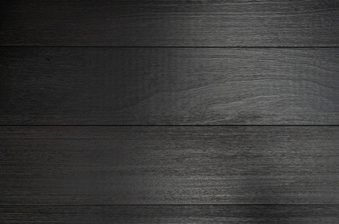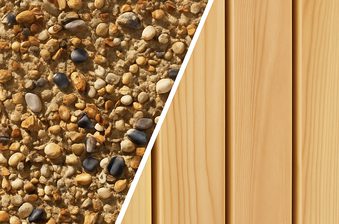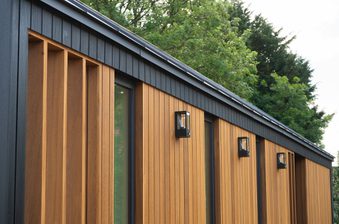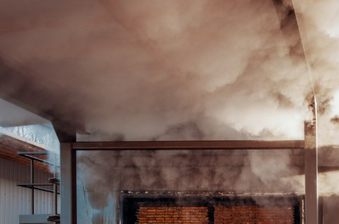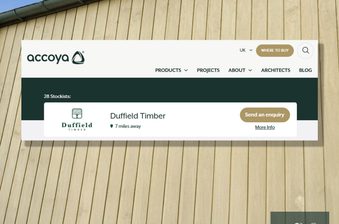Rainscreen cladding — also known as splayed or rhombus cladding — provides a decorative, contemporary touch, but it’s quite different to other popular cladding profiles.
Unlike V-groove, shadow gap and shiplap, rainscreen cladding boards are not connected. This can provide the finished product with an undeniably unique and eye-catching appearance, at the expense of waterproofing.
Considering rainscreen for your next project? Let’s explore this unique profile in a little more detail.
What is timber rainscreen cladding?
Rainscreen cladding, also known as ‘splayed’, ‘rhombus’ or ‘open jointed’ cladding, is made up of boards that are cut at an angle to provide a chamfered edge on each side, producing a parallelogram shape. Once installed, these boards are equally spaced apart (usually between 5mm and 10mm) to form a clean, contemporary shadow slat appearance.
Rainscreen cladding is so-called because the profile’s shape encourages water runoff; installed boards create an overlap. Unlike most other types of cladding, rainscreen cladding boards are not interlocked or connected. As a result, it should only be applied to a structure that is fully waterproofed.


The pros and cons of using rainscreen cladding: is it right for my project?
A cladding profile that can provide a contemporary decorative touch and design flexibility, rainscreen is suitable for architecturally-led projects of any size. Since the boards are not interconnected, rainscreen provides optimal ventilation, but it should only be applied to structures that are waterproofed.
It’s architecturally stunning
Once installed, the gaps between the boards produce a sleek look, with strong, eye-catching shadow lines that cascade throughout the day as a result of the sun’s movement or any lighting in your space. The consistent linear appearance is easy on the eye, with the beauty of timber as a natural material adding to the visual appeal.
Humans are biophilic creatures — that is, we have an innate attraction to nature. Materials like wood make us feel good. Biophilic design — the use of nature and natural materials when creating spaces to increase our connection to them — is on trend, and this underlies rainscreen cladding’s suitability for design-led spaces.
It offers design flexibility
Rainscreen cladding can be installed horizontally or vertically, providing plenty of freedom to get creative. The use of a mixed width arrangement can add further design flair — it can even be installed at an angle, or with a mixture of orientations.
It’s sustainable
Timber is a 100% renewable material that, during its life cycle, absorbs greenhouse gases from the atmosphere. This can suit it to new and retrofit projects with a sustainable focus, or just for making a sustainable statement with natural, eye-catching flourish to design-led outdoor spaces.
So, as well as the aesthetic benefits and design flexibility, rainscreen cladding (indeed, all timber cladding) represents a long-lasting, eco-conscious choice. By choosing a quality, naturally durable species (such as those we’ll mention later on), rainscreen cladding can last for many, many decades.
It optimises ventilation, insulation and allows for movement
Timber is a hygroscopic material, meaning it gains and loses moisture as it interacts with the surrounding atmosphere. Since the boards do not interlock unlike with tongue and groove cladding, rainscreen allows air and light to pass through, meaning optimal ventilation.
With the gaps, rainscreen naturally permits for more dimensional movement (shrinking and swelling) than other types of cladding profile, guarding against swelling and bulging that can sometimes plague poorly-installed tongue and groove cladding. The chamfered edges mean that the boards overlap, helping to drain water away.
Rainscreen cladding can also boost a building’s heat efficiency, as well as protecting against UV damage. When retrofitting a very old building that may not be able to be internally insulated, a professionally installed rainscreen cladding system can be a solution.
… but it doesn’t provide waterproof protection
Functional though it may be for allowing ventilation and movement, since the boards have gaps in between, rainscreen does not provide a waterproof surface. As such, it’s not suitable for use on a non-waterproofed structure, like a garden shed.
It should only be applied on buildings where layers of waterproof and protective materials are installed behind the cladding, or on areas where exposure to the elements won’t compromise any structures it’s applied to.
Reckon rainscreen could be suitable for your project? Let’s delve into a little more detail about choosing the right type for your project and budget.
The different types of rainscreen cladding
When choosing a type of rainscreen cladding, you’ll need to select a size — relating to the dimensions of each cladding board — and a species (the type of tree the wood comes from).
Choosing a rainscreen cladding size and dimension
One of the most popular specifications of rainscreen cladding we offer is the clean, contemporary DTC27 profile. Each board has a size of 18x94, providing 86mm of cover when installed. DTC28 has a larger board, meaning your cladding will cover more surface once installed (136mm per board).
The rainscreen profile you choose will, of course, depend on your aesthetic vision.
Another consideration might be cost; as it uses larger boards, profiles that provide more cover typically cost more per m². Western Red Cedar in our DTC28 profile, with its greater cover provided per board, costs £72.80 + VAT per m². Contrast that to DTC27, coming in at £62.80 + VAT per m². *
* Costs are correct as of early 2024 and are subject to change.
It's also worth noting that you can have similar open-jointed cladding styles, including straight edge and straight edge with round corners. This is a rainscreen style of cladding, but a smart alternative to the rhombus shape.
Choosing a rainscreen cladding species
Popular species for rainscreen cladding include beautiful, durable classics like Western Red Cedar, Siberian Larch and Alaskan Yellow Cedar. On-trend too are modified timbers like ThermoWood, and Thermo-Ayous — their tropical dark brown tones effortlessly exude luxuriousness.
Your choice of species will come down to design preference. Western Red Cedar’s versatile, eye-catching reddish-brown hues slot seamlessly into any outdoor space, whilst Larch and Yellow Cedar offer similarly timeless natural beauty with pale-golden yellows — or maybe you’ll plump for the exotic vibes of a thermally treated species.
Cost may also factor into your decision making process. Western Red Cedar rainscreen cladding in our DTC27 profile comes in at £62.80 + VAT per m²; the equivalent in Thermo-Nordic Pine runs you £38.95 per m². Clearly, when cladding a space, the choice of species can drastically affect project price.
Rainscreen cladding in three different timber species: Western Red Cedar, Alaskan Yellow Cedar and ThermoWood.
Calculating the cost of your rainscreen cladding project
Be sure to check out our guide on measuring and pricing up your cladding project. Cost depends on the amount of cladding required, the species chosen and even the dimensions of your rainscreen cladding boards.
There’s no denying that Western Red Cedar is one of the most popular species for rainscreen cladding, and this is reflected in its premium price point.
But if its reddish-browns really appeal to you but are slightly outside of your project budget, fear not. Many home improvers running a tighter budget choose to stain Alaskan Yellow Cedar cladding with a product like Owatrol Textrol HES (Cedar), after which it bears very close resemblance Western Red Cedar.
In terms of natural durability, the two species are almost indistinguishable, performing admirably outdoors.
Horizontal or vertical timber rainscreen cladding?
Whether installed horizontally or vertically, rainscreen cladding looks architecturally smart. Horizontal is the more traditional orientation; it may be useful to create an impression of greater size in a small outdoor area. Vertical can create a designer statement, adding height — it creates a seamless line for our eyes to follow, perhaps suitable for a large commercial building.
You could also mix up your orientations, or use boards of varying widths to make a statement. Rainscreen cladding offers a great deal of flexibility.
For more information, be sure to check out our guide comparing vertical or horizontal cladding!
Installation of timber rainscreen cladding
Unless you’ve got the technical skills in-house, we’d recommend hiring a specialist to install your cladding. The amount of time required varies tremendously depending on the size and complexity of your project.
Be sure to use stainless steel screws. These give you maximum control over the fixing, preventing the trapping of moisture and allowing for easy repair and replacement further down the line.
Maintenance and ongoing care for your rainscreen cladding
Since the cladding provides optimal ventilation and the risk of swelling and bulging is reduced, rainscreen can be seen as a lower maintenance type of cladding, particularly when you choose one of the quality timber species we mentioned earlier.
That said, rainscreen can still benefit from a little TLC to stay looking its resplendent best. To avoid the gradual greying effect of moisture and the sun UV’s, consider a periodical gentle scrub with warm, soapy water and the application of an appropriate treatment. Although don’t forget that rustic, ‘old look’ cladding is actually very much on trend at the moment!
Planning a rainscreen cladding project?
Let’s get started! Whether you’re doing a bit of home improvement or working on a large-scale commercial project, we can help.
Once you’ve decided on one of our rainscreen cladding profiles, choose from our selection of beautiful, durable timbers, including Western Red Cedar, Siberian Larch, European Oak, Douglas Fir and more.
Don’t forget those high-performance, gorgeous modified species like Thermo-Nordic Pine either. All of our cladding is machined to profile on-site to order.
We supply all the other popular cladding profiles too, of course, including the smart tongue & V-groove, the stylish shadow gap and the timeless shiplap — and many more!
As an very stylish alternative to the rhombus shape of rainscreen, we also offer straight edge cladding, as well as straight edge with round corners.
We’re here at every stage, right from initial enquiry through to delivery of your cladding. Get in touch by clicking the button below. You can also reach us through our contact page, by phoning 01765 640 564 or emailing sales@duffieldtimber.com.

